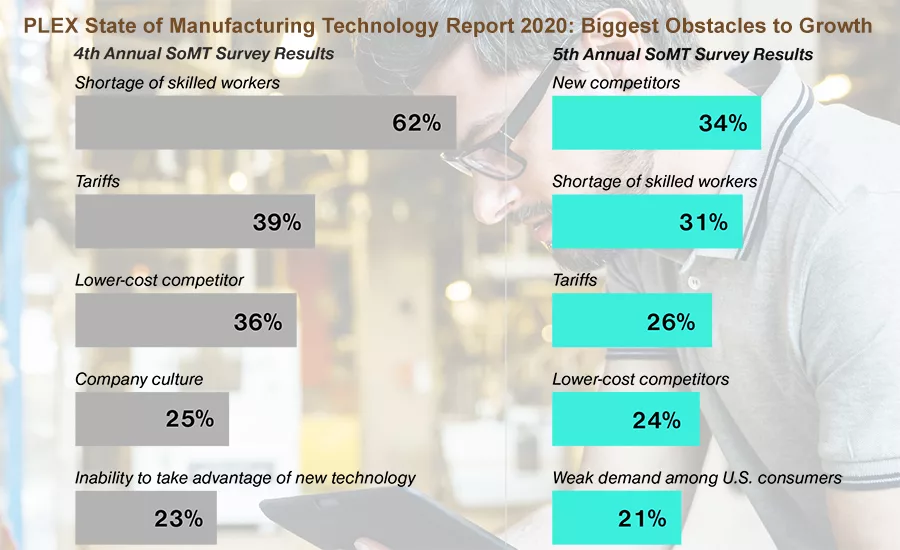Manufacturing News
Study reveals manufacturers face new competition as biggest growth obstacle in 2020
But when it comes to adopting new technologies, food and beverage manufacturers are out in front of other industrial categories

The results are in for PLEX’s State of Manufacturing Report 2020, and they show the food and beverage industry is in many ways out in front of other industries in terms of adopting new technologies to maximize efficiency, competitiveness and profits. The study, developed with the support of LNS Research, surveyed approximately 200 manufacturers from all categories who revealed a desire to realize the alluring promise of smart manufacturing. The study explores common manufacturing challenges alongside evolving technology solutions, with looking toward creating a blueprint that helps companies navigate and achieve business transformation.
While the study was conducted in December 2019 before the breakout of COVID-19, the vast majority (92%) of manufacturers responding to the survey had grown financially—or remained flat—in 2019. The momentum of 2019 made many manufacturers optimistic about their future, with most planning for ongoing growth this year.
When manufacturers were asked in 2019 what they see as the biggest obstacles to growth in 2020, they answered in the following order: new competitors (34% responding), shortage of skilled workers (31%), tariffs (26%) and lower-cost competitors (24%). Last year, 62% or respondents said shortage of skilled workers was a critical problem, 39% cited tariffs, 36% noted lower-cost competitors, 25% reported company culture, and 23% said that inability to take advantage of new technology were obstacles to growth.
For the first time in this report’s history, “new competitors” emerged as number one on the list of manufacturers’ obstacles to growth. Manufacturers are concerned about the competition—whether new or lower cost, foreign or domestic, large or small—because they believe they’re being outpaced in three key areas:
- 26% say they do not have the right strategy.
- 26% say they do not have enough skilled workers.
- 23% say they do not have the capital to compete.
With the emergence of COVID-19, it’s possible that these “new competitors” will become even more formidable due to a combination of financial resources becoming available through economic stimulus packages offering low interest rates and grants and startups’ characteristic agility to adapt quickly to changing market needs, says the report.
It’s to be expected that COVID-19 has likely changed the priority of the above concerns for the rest of 2020—and the data to support this re-prioritization. When this survey was conducted, only 16% of respondents mentioned supply chain disruption as an obstacle to growth. However, according to a recent survey conducted by the National Association of Manufacturers from Feb. 28-March 9, 2929, 35.5% of its member companies were already facing supply chain disruptions at a time when the coronavirus was just starting its rapid spread through Europe and the U.S.
Food industry no longer slackers
When I started with Food Engineering almost 15 years ago, I was previously senior technical editor for a sister magazine at the now non-existent Chilton Publishing in suburban Philadelphia. The sister magazine, Control Solutions, covered all areas of manufacturing—not just food and beverage, but also automotive, oil and gas, pulp and paper, etc. Back then, the food and beverage industry would have easily been considered the “laggards” in adopting new technologies.
Today, a single trip to the grocery store will tell you the food industry is a highly competitive market with new products coming out almost on a daily basis—at least around the perimeter of the store. Products in the inner aisles have seen changes, too. And COVID-19 has given them a new lease on life, meaning that the whole food and beverage industry is very competitive, and processors realize they need new tools to stay on top.
In PLEX’s study, one-third of respondents come from food and beverage, and there are some surprising revelations, says Kaitlin Rebella, PLEX senior manager. Here are three findings not listed in the report itself, which shows a tendency of food and beverage processors to adopt new technologies faster than their peer manufacturers:
- Food and beverage manufacturers are less likely than their peers to say that skilled workers is impending their growth. Only 21% are concerned, while 44% of auto manufacturers, for instance, see it as a challenge.
- Food and beverage processors appear to be more successful than general manufacturers at quickly piloting new technology. 43% of food and beverage manufacturers are considered industrial transformation leaders, according to criteria defined by research firm LNS Research.
- The food industry is leveraging cutting edge technology, with 17% utilizing 3-D printing/additive manufacturing or smart wearables in their operations, and another 14% of respondents sharing that they use either blockchain, generative design, or industry benchmarking.
Sanders and Morely Candy is a fine chocolatier that has invested in new hardware and software through new production lines, automating packaging processes and adopting a cloud-based ERP system, giving the company greater visibility and control over its operations. These changes have helped the company achieve double-digit growth, with plans to reach $100 million in revenues in the coming years.
For more information on the study, “5th Annual State of Manufacturing Technology Report” and to read it in its entirety, visit PLEX’s website.
Looking for a reprint of this article?
From high-res PDFs to custom plaques, order your copy today!






